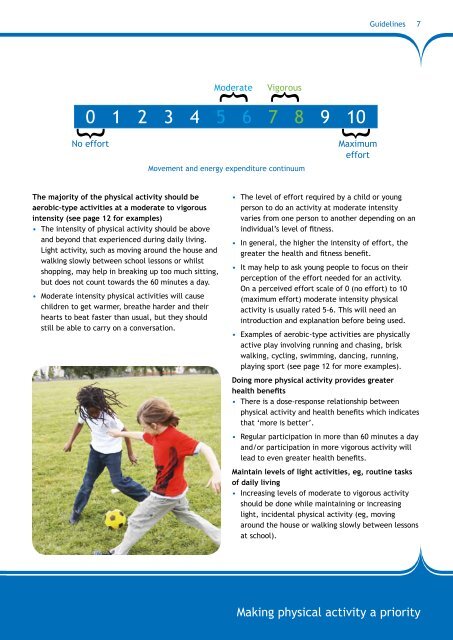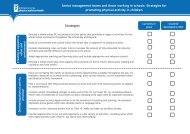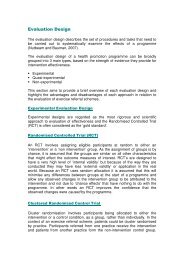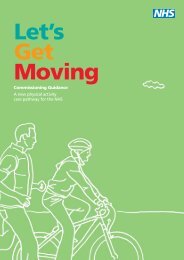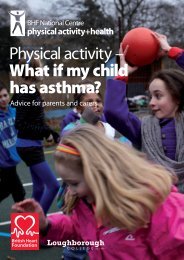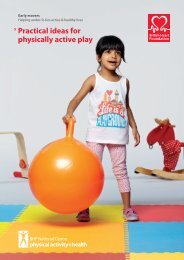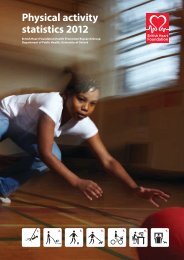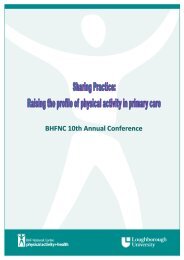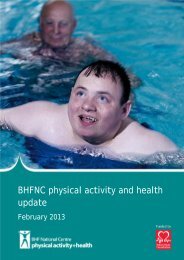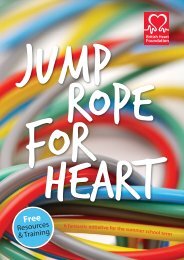Interpreting the UK physical activity guidelines for children and ...
Interpreting the UK physical activity guidelines for children and ...
Interpreting the UK physical activity guidelines for children and ...
You also want an ePaper? Increase the reach of your titles
YUMPU automatically turns print PDFs into web optimized ePapers that Google loves.
}<br />
}<br />
Guidelines<br />
7<br />
Moderate<br />
Vigorous<br />
}<br />
}<br />
0 1 2 3 4 5 6 7 8 9 10<br />
No ef<strong>for</strong>t<br />
Movement <strong>and</strong> energy expenditure continuum<br />
Maximum<br />
ef<strong>for</strong>t<br />
The majority of <strong>the</strong> <strong>physical</strong> <strong>activity</strong> should be<br />
aerobic-type activities at a moderate to vigorous<br />
intensity (see page 12 <strong>for</strong> examples)<br />
• The intensity of <strong>physical</strong> <strong>activity</strong> should be above<br />
<strong>and</strong> beyond that experienced during daily living.<br />
Light <strong>activity</strong>, such as moving around <strong>the</strong> house <strong>and</strong><br />
walking slowly between school lessons or whilst<br />
shopping, may help in breaking up too much sitting,<br />
but does not count towards <strong>the</strong> 60 minutes a day.<br />
• Moderate intensity <strong>physical</strong> activities will cause<br />
<strong>children</strong> to get warmer, brea<strong>the</strong> harder <strong>and</strong> <strong>the</strong>ir<br />
hearts to beat faster than usual, but <strong>the</strong>y should<br />
still be able to carry on a conversation.<br />
• The level of ef<strong>for</strong>t required by a child or young<br />
person to do an <strong>activity</strong> at moderate intensity<br />
varies from one person to ano<strong>the</strong>r depending on an<br />
individual’s level of fitness.<br />
• In general, <strong>the</strong> higher <strong>the</strong> intensity of ef<strong>for</strong>t, <strong>the</strong><br />
greater <strong>the</strong> health <strong>and</strong> fitness benefit.<br />
• It may help to ask young people to focus on <strong>the</strong>ir<br />
perception of <strong>the</strong> ef<strong>for</strong>t needed <strong>for</strong> an <strong>activity</strong>.<br />
On a perceived ef<strong>for</strong>t scale of 0 (no ef<strong>for</strong>t) to 10<br />
(maximum ef<strong>for</strong>t) moderate intensity <strong>physical</strong><br />
<strong>activity</strong> is usually rated 5-6. This will need an<br />
introduction <strong>and</strong> explanation be<strong>for</strong>e being used.<br />
• Examples of aerobic-type activities are <strong>physical</strong>ly<br />
active play involving running <strong>and</strong> chasing, brisk<br />
walking, cycling, swimming, dancing, running,<br />
playing sport (see page 12 <strong>for</strong> more examples).<br />
Doing more <strong>physical</strong> <strong>activity</strong> provides greater<br />
health benefits<br />
• There is a dose-response relationship between<br />
<strong>physical</strong> <strong>activity</strong> <strong>and</strong> health benefits which indicates<br />
that ‘more is better’.<br />
• Regular participation in more than 60 minutes a day<br />
<strong>and</strong>/or participation in more vigorous <strong>activity</strong> will<br />
lead to even greater health benefits.<br />
Maintain levels of light activities, eg, routine tasks<br />
of daily living<br />
• Increasing levels of moderate to vigorous <strong>activity</strong><br />
should be done while maintaining or increasing<br />
light, incidental <strong>physical</strong> <strong>activity</strong> (eg, moving<br />
around <strong>the</strong> house or walking slowly between lessons<br />
at school).<br />
Making <strong>physical</strong> <strong>activity</strong> a priority


